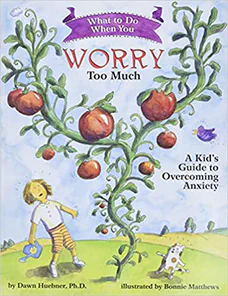What to Do When You Worry Too Much
A Kid's Guide to Overcoming Anxiety
Written by Dawn Huebner, Ph.D.
Illustrated by Bonnie Matthews
80 pages
•
Published 2005 (Magination Press)

Recommended Age Range: Ideal for 1st graders through 5th graders.
Publisher's Summary:
What to Do When You Worry Too Much guides children and parents through the cognitive-behavioral techniques most often used in the treatment of anxiety. Lively metaphors and humorous illustrations make the concepts and strategies easy to understand, while clear how-to steps and prompts to draw and write help children to master new skills related to reducing anxiety. This interactive self-help book is the complete resource for educating, motivating, and empowering kids to overcome their overgrown worries.

Dr. Annie's Takeaways
Recommended for: Children struggling with too many worries who want to worry less will likely benefit from going through this interactive workbook with a trusted adult and practicing the recommended skills. It’s a collection of evidence-based practices
for worry management, and for some kids, this workbook might be enough to help them learn to get their worries under control! For kids who need a little more support, this workbook could still be a great supplement to therapy. Also available in Spanish.
Would a child like it? This book is extremely reassuring. It provides a road map to worry management, and although it acknowledges that taming worries is a lot of work, it is very optimistic. The drawing/writing prompts are a fun and engaging addition to the book.
Evidence-Based Practices:
Psychoeducation, Cognitive Restructuring, Diaphragmatic Breathing, Progressive Muscle Relaxation
Tone: Instructive, reassuring, a bit silly
Story Quality: It’s a workbook/ self-help book, rather than a story. The explanations are clear, and the metaphor of worries growing like a tomato plant is effective. It’s a bit silly at times without ever veering towards making fun of children’s worries. The workbook is broken up into nine chapters (e.g., How Do Worries Get Started; Talking Back to Worries, Re-setting Your System) that each provide a drawing/writing prompt (e.g, “Draw what your worry bully looks like”).
Illustrations: Black-and-white watercolor illustrations that supplement the text. Each page has an illustration, but some pages are dominated by text.
Representation: Many different children are portrayed in the illustrations throughout the text (i.e., children with different skin tones, hair, and genders). A few examples include mentions of Mom or of Dad, but it’s never explicitly implied that all children have a mom and a dad. There is one illustration of a family, which seems to include a mom, dad, and their children. There is a section that talks about the heritability of worries, which only applies to children who know their biological families. Of note, this book also comes in a Spanish language version.
Psychological Practices: This book is such a good primer on evidence-based treatment for children’s worries (i.e., Cognitive Behavioral Therapy(CBT)
for worries). It covers what a worry is; how it makes our bodies feel (connecting somatic symptoms to worries); problem solving; Worry Time (i.e., containing worries to a set time each day); a Worry Box (i.e., an imaginary place to store worries when it isn’t Worry Time); talking back to a Worry Bully; exercise as a way of “re-setting” one’s body; and relaxation strategies including progressive muscle relaxation, diaphragmatic breathing
, and visualizations.
Concerns: Nope. These are the greatest hits of CBT for Generalized Anxiety Disorder.
